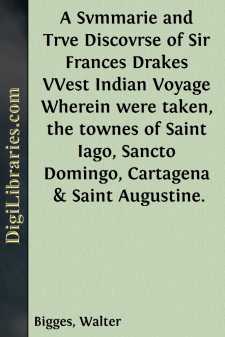Categories
- Antiques & Collectibles 13
- Architecture 36
- Art 48
- Bibles 22
- Biography & Autobiography 813
- Body, Mind & Spirit 138
- Business & Economics 28
- Children's Books 12
- Children's Fiction 9
- Computers 4
- Cooking 94
- Crafts & Hobbies 4
- Drama 346
- Education 46
- Family & Relationships 57
- Fiction 11821
- Games 19
- Gardening 17
- Health & Fitness 34
- History 1377
- House & Home 1
- Humor 147
- Juvenile Fiction 1873
- Juvenile Nonfiction 202
- Language Arts & Disciplines 88
- Law 16
- Literary Collections 686
- Literary Criticism 179
- Mathematics 13
- Medical 41
- Music 40
- Nature 179
- Non-Classifiable 1768
- Performing Arts 7
- Periodicals 1453
- Philosophy 64
- Photography 2
- Poetry 896
- Political Science 203
- Psychology 42
- Reference 154
- Religion 505
- Science 126
- Self-Help 81
- Social Science 81
- Sports & Recreation 34
- Study Aids 3
- Technology & Engineering 59
- Transportation 23
- Travel 463
- True Crime 29
Drake's Great Armada
by: Walter Bigges
Description:
Excerpt
INTRODUCTION
Nearly five years elapsed between Drake's return from his Famous Voyage and the despatch of the formidable armament commemorated in the following pages. During the last of these years the march of events had been remarkably rapid. Gilbert, who had been empowered by Elizabeth, in the year of Frobisher's last expedition, to found colonies in America, had sailed for that purpose to Newfoundland (1583), and had perished at sea on his way homeward. Raleigh, who had succeeded to his half-brother's enterprises, had despatched his exploring expedition to 'Virginia,' under Amadas and Barlow, in 1584, and had followed it up in the next year (1585) by an actual colony. In April Sir Richard Greenville sailed from Plymouth, and at Raleigh's expense established above a hundred colonists on the island of Roanoak. Drake's Great Armada left Plymouth in September of the same year. It marked a turning-point in the relations between the English and Spanish monarchs. Elizabeth, knowing that the suppression of the insurrection in the Netherlands would be followed by an attack upon England, was treating with the insurgents. Philip deemed it prudent to lay an embargo on all her subjects, together with their ships and goods, that might be found in his dominions. Elizabeth at once authorized general reprisals on the ships and goods of Spaniards. A company of adventurers was quickly formed for taking advantage of this permission on a scale commensurate with the national resources. They equipped an armada of twenty-five vessels, manned by 2,300 men, and despatched it under the command of Drake to plunder Spanish America. Frobisher was second in command. Two-thirds of the booty were to belong to the adventurers; the remaining third was to be divided among the men employed in the expedition.
Drake's armament of 1585 was the greatest that had ever crossed the Atlantic. After plundering some vessels at the Vigo river, he sailed for the West Indies by way of the Canaries and Cape Verde Islands, hoisted the English flag over Santiago and burnt the town, crossed the Atlantic in eighteen days, and arrived at Dominica. At daybreak, on New Year's Day, 1586, Drake's soldiers landed in Espanola, a few miles to the west of the capital, and before evening Carlile and Powell had entered the city, which the colonists only saved from destruction by the payment of a heavy ransom. Drake's plan was to do exactly the same at Carthagena and Nombre de Dios, and thence to strike across the isthmus and secure the treasure that lay waiting for transport at Panama. Drake held St. Domingo for a month, and Carthagena for six weeks. He was compelled to forego the further prosecution of his enterprise. A deadly fever, which had attacked the men during the sojourn at Santiago, still continued its ravages. In existing circumstances, even had Nombre de Dios been successfully attacked, the march to Panama was out of the question; and after consultation with the military commanders, Drake resolved on sailing home at once by way of Florida....



